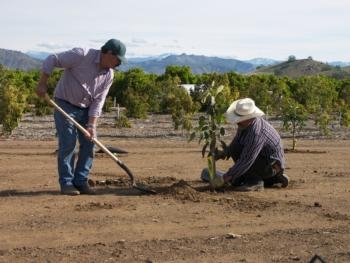"Trees should be firmly staked at planting"
MYTH!!!!!!!!!!!!!!! Read on:
Chalker-Scott, L. , Extension Specialist And Associate Professor, Washington State University
Downer, A.J., Farm Advisor, University of California
Nursery-grown shade trees are often rigidly staked to prevent blowdown and damage during cultivation. In some cases, trees are pruned to a long, untapered standard with a bushy top that requires a tight stake to hold it up. Nurseries often remove side branches from the young trunk and while this creates the illusion of a small tree, the practice actually inhibits the development of taper in the trunk (Harris, 1984; Neel and Harris, 1971). Trees without taper will not stand without staking. Poor culture of ornamental trees in nurseries necessitates staking once trees are planted into landscapes because they do not have the structural development in their trunks to stand on their own. Due to these cultivation errors, landscape installers frequently keep the nursery stake and add more stakes to firmly secure the tree in place and further prevent its movement in the landscape.
Staking takes three basic forms: rigid staking, guying, and anchoring. All methods of staking reduce development of taper, increase height growth, and decrease caliper of the developing tree relative to unstaked trees (Figure 7). Moreover, improper staking can result in increased tree breakage either during the staking period or after staking is removed (Figure 8a-b) (Thacker et al., 2018).
Decades ago, researchers discovered that movement of the trunk and branches is necessary for the development of trunk taper (Neel and Harris, 1971). Trees grown in a growth chamber without movement did not develop taper and instead grew taller, while trees in an identical chamber that were hand shaken each day developed significant taper and remained shorter.
Until trees are established in landscapes they may require some staking. In areas of high wind, guying (which involves cables staked to the ground) gives the greatest protection against main stem breakage or blowover (Alvey et al., 2009). Whatever system is used, any such hardware should be removed as soon as the tree can stand on its own:
- The traditional two stakes and ties system is the least harmful to trees staked in landscapes.
- Staking should be low and loose to allow trunk taper to develop naturally.
- Remove all staking material as soon as possible.
If a tree is not established after a year of staking, it is unlikely to ever establish
Read on:
